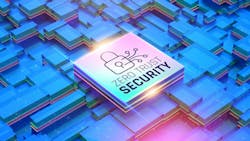Zero Trust at the Door: Extending Cybersecurity to Physical Access Systems
Key Highlights
- In today’s security landscape, CIOs, CISOs, and facility managers can no longer assume physical access systems are safe—every badge reader, camera, and controller is a potential network entry point.
- Physical devices such as readers, sensors, and controller, must authenticate and verify on each signal.
- Retrofits such as secure modules and scene verification allow legacy systems to join the Zero Trust model.
- Video feeds should include markers to detect feed looping or manipulation.
- Secure field controllers enforce multi-protocol authentication across access control, intrusion, and OT layers.
In the evolving security landscape, it’s no longer enough for defenders to assume physical access systems are safe by default. For CIOs, CISOs, facility managers, and security leads, every badge reader, camera, and controller is now a potential hop into your network. Just as Zero Trust disrupted expectations for users and applications, it must also rewrite how we trust the devices at our doors. The devices you once treated as benign peripherals now operate at the intersection of physical and digital risk, and they need continuous verification, not perimeter privilege.
Rather than tearing out legacy infrastructure, leading organizations are adopting retrofit modules, scene validation markers, and secure field controllers to weave physical systems into unified Zero Trust models.
As reported by Seth Riser, Steven Brown, and Thomas Segars in “Zero Trust at the Door: A Physical Security Responsibility” on SecurityInfoWatch:
“Zero Trust is not limited to network firewalls and user accounts. It applies to every device and system that interacts with your environment. If you operate badge readers, intrusion sensors, cameras, or control panels, you are already in the middle of the Zero Trust problem.
What Zero Trust Means in Practice
Zero Trust is often referred to as a strategy, but to implement it, you have to use solutions that support the core rule of never trust, always verify. Nothing is allowed to operate without proving its identity and authorization, not just once but continuously.
In physical security, you already use elements of this principle. Two-factor authentication for a secure room, a guard matching a photo to the person holding the badge, or dual authorization for certain actions are all examples. The difference now is that this level of scrutiny must extend to the devices themselves, the connections between them, and the data they send.
Every device in your environment is an edge device. A badge reader, a motion sensor, a camera, or a controller all sit at the point where the physical world meets the digital network. If an attacker can compromise one, they can use it to reach deeper into your systems.
Legacy devices are often the weakest point. Many were designed for an era when physical systems were separate from IT. They were not built to authenticate themselves or their data. Many still rely on outdated verification methods like end-of-line resistors, which can be bypassed in seconds.
Continuous Verification at the Physical Edge
In Zero Trust, users, devices, and data must both authenticate and verify. Authentication confirms identity. Verification confirms that the user, device, or data is still authorized and has not been altered. For example, a motion sensor should not just send an open or closed signal. It should also prove it is the genuine device you installed and that it has not been altered.
Addressing the vulnerabilities of cyber-physical systems through zero trust necessitates an approach that avoids costly and time-consuming rip/replace procurement strategies by supporting both new and legacy devices and infrastructure. Software and hardware that enable a device to authenticate and verify itself to the controller each time it sends a signal. In practice, that means an old door contact or sensor can be brought into a Zero Trust framework without replacement- the equivalent of adding a high-security lock to a door, but the lock checks itself every time it is used.”
Authentication alone is insufficient if the system cannot detect data manipulation. Video is a clear example. In multiple incidents, attackers have looped recorded footage or inserted false images to hide movement. Operators believed they were seeing live video because the feed appeared normal.”
Continue reading “Zero Trust at the Door: A Physical Security Responsibility” by Seth Riser, Steven Brown & Thomas Segars on SecurityInfoWatch.
Why It Matters to You
For TechEDGE readers overseeing security architectures, infrastructure deployments, or hybrid edge/OT environments, the physical edge is a potential attack vector. Adversaries increasingly exploit badge cloning, video feed tampering, or controller spoofing as backdoors into critical systems. Integrating Zero Trust into physical systems ensures that every device, connection, and signal earns its trust continuously.
Because many organizations still treat physical and cybersecurity separately, opportunities for compromise abound. By embedding continuous device verification, scene-level video integrity checks, and secure controller logic, you can make your infrastructure resilient to attacks that begin at the door, not inside the firewall.
Next Steps
- CISO/Security Lead: Assess your physical security inventory (cameras, readers, sensors, controllers) and categorize by retrofit eligibility and critical risk.
- Security/Physical Ops: Pilot secure device authentication modules and scene verification markers on one high-risk entry point or camera feed.
- Architecture/Engineering Team: Standardize integration paths so all physical systems feed into centralized identity and trust frameworks.
- Facilities/OT Leadership: Replace or retrofit controllers with secure field controllers that verify device legitimacy and support multi-protocol authentication.
- Governance/Risk: Define metrics—percent of devices continuously verified, anomalous feed detections, unauthorized device attempt rates—and report into board-level risk dashboards.
Quiz
Stay ahead of the curve with weekly insights into emerging technologies, cybersecurity, and digital transformation. TechEDGE brings you expert perspectives, real-world applications, and the innovations driving tomorrow’s breakthroughs, so you’re always equipped to lead the next wave of change.

